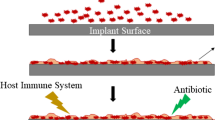The interaction between implanted materials and body tissues at the cellular level is a critical factor for the success of biomedical implants. Surface modifications, including grinding, polishing, abrasive blasting, and chemical etching together with the application of bioactive coatings such as calcium phosphates are commonly employed to improve implant performance. Each surface treatment alters the topology, roughness, and residual mechanical stresses in the material which can affect cellular responses. In this study, we examine the impact of various surface treatments on the surface morphology, stress state, and elemental composition of titanium alloy samples comparable to commercially available implants. The residual stress values, measured using XRD, have been found to be 400 ± 5 MPa for polished samples, 350 ± 10 MPa for rolled samples, 345 ± 5 MPa for abrasive blasted samples, 215 ± 3 MPa for etched samples, and 260 ± 10 MPa for coated samples. Given the potential influence of residual stress gradients on cell behavior, it is important to consider the stress state as a criterion for implant biocompatibility. Further investigation into the relationship between the residual stress and the cellular responses will contribute to the development of more effective implant materials and surface treatments, ultimately enhancing osseointegration and overall implant performance. This study highlights the need for a comprehensive understanding of the role of the residual stress in implant biocompatibility and suggests a novel direction for future research in this field.
Similar content being viewed by others
References
R. Krishna Alla, K. Ginjupalli, N. Upadhya, et al., Trends Biomater. Artif. Organs, 25 (3), 112 (2011).
H. Shahali, A. Jaggessar, and P. K. D. V. Yarlagadda, Procedia Eng., 174, 1067 (2017).
I. A. Khlusov, N. M. Shevtsova, M. Y. Khlusova, et al., Genes Cells, 6, 55 (2011).
I. A. Khlusov, M. Y. Khlusova, V. F. Pichugin, et. al., Russ. Phys. J., 56, 92 (2013).
I. V. Rodionov, Perspekt. Mater., 6, 45 (2008).
V. P. Mantripragada, B. Lecka-Czernik, N. A. Ebraheim, and A. C. Jayasuriy, J. Biomed. Mater. Res. Part A, 101, No. 11, 3059–3364 (2013).
Q. Chen and G. A. Thouas, Mat. Sci. Eng. R Rep., 87, 1–57 (2015).
M. A. Khimich, K. A. Prosolov, T. Mishurova, et al., Nanomaterials, 11, No. 5, 1159 (2021).
T. Stich, F. Alagboso, T. Křenek, et al., Bioeng. Transl. Med., 7, No. 1, e10239 (2022).
T. Guo, S. Ivanovski, and K. Gulati, Mater. Des, 223, 111110–111119 (2022).
L. Le Guehennec, A. Soueidan, P. Layrolle, and Y. Amouriq, Dent. Mater., 23, No. 7, 844–854 (2007).
X. Liu, P. K. Chu, and C. Ding, Mat. Sci. Eng. R Rep., 47, Nos. 3–4, 49–121 (2004).
M. Ogiso, M. Yamamura, P. T. Kuo, et al., J. Biomed. Mater. Res., 39 (3), 364–372 (1998).
V. V. Savich, D. I. Saroka and M. G. Kiselev, Modification of the Surface of Titanium Implants and Its Effect on Their Physicochemical and Biomechanical Parameters in Biological Media, Minsk (2012).
K. A. Prosolov, V. V. Lastovka, M. A. Khimich, V. V. Chebodaeva, I. A. Khlusov and Y. P. Sharkeev, Materials, 15(19), 6828 (2022).
K. A. Prosolov, V. V. Lastovka, O. A. Belyavskaya, et al., Materials, 13 (19), 4449–4469 (2020).
E. Velasco, L. Monsalve-Guil, A. Jimenez, et. al., J. Oral Implantol., 42 (6), 469–476 (2016).
L. Romano-Brandt, E. Salvati, E. Le Bourhis, et. al., Surf. Coat. Technol., 381, 125142 (2020).
E. R. Urquia Edreira, J. G. C. Wolke, J. te Riet, et. al., Surf. Coat. Technol. 266, 177–182 (2015).
D. R. Jung, R. Kapur, T. Adams, et. al., Crit. Rev. Biotechnol., 21 (2), 111–154 (2001).
M. Ladd and R. Palmer, Structure Determination by X-ray Crystallography. Analysis by X-rays and Neutrons, Springer, New York (2013).
H. M. Rietveld, Acta Crystallogr. 22, 151–152 (1967).
M. Chimmat and D. Srinivasan, Procedia Struct. Integr., 14, 746–757 (2019).
M. Hasegawa, J. Saruta, M. Hirota, et al., Int. J. Molec. Sci., 21 (3), 783–800 (2020).
J. I. Rosales-Leal, M. A. Rodriguez-Valverde, G. Mazzaglia, et. al., Colloids Surf. Physicochem. Eng. Asp., 365 (1), 222–229 (2010).
J. C. Balza, D. Zujur, L. Gil, et. al., IOP Conf. Ser. Mater. Sci. Eng., 45, 012004 (2013).
K. D. Park, B. A. Lee, X. H. Piao, et. al., J. Adv. Prosthodont., 5 (4), 402–408 (2013).
L. K. Kriechbaumer, W. Happak, K. Distelmaier, et. al., J. Orthop. Res. 38 (11), 2464–2473 (2020).
F. Rupp, L. Scheideler, D. Rehbein, et. al., Biomaterials, 25 (7), 1429–1438 (2004).
S. M. Al-Zubaidi, A. A. Madfa, A. A. Mufadhal, et. al., Front. Mater., 7, 106 (2020).
Author information
Authors and Affiliations
Corresponding author
Rights and permissions
Springer Nature or its licensor (e.g. a society or other partner) holds exclusive rights to this article under a publishing agreement with the author(s) or other rightsholder(s); author self-archiving of the accepted manuscript version of this article is solely governed by the terms of such publishing agreement and applicable law.
About this article
Cite this article
Prosolov, K.A., Khimich, M.A. & Sharkeev, Y.P. Surface Treatments and Residual Stress: Assessing the Implications for Biocompatibility in Titanium Implants. Russ Phys J 66, 116–123 (2023). https://doi.org/10.1007/s11182-023-02912-5
Received:
Published:
Issue Date:
DOI: https://doi.org/10.1007/s11182-023-02912-5




